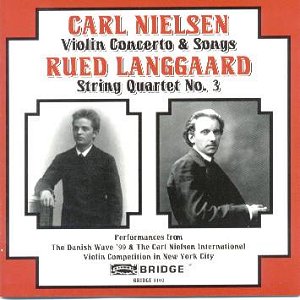These performances are drawn from the Danish Wave Festival
and from the Carl Nielsen International Violin Competition, both of
which were held in New York in 1999. It makes for individually appealing
but programmatically eclectic listening – which is no bad thing once
in a while. Together baritone Lars Thodberg Bertelsen and pianist Frode
Stengaard perform five of Nielsen’s songs. There is a sense of direction
and rapt simplicity in the semi strophic Sang bag Ploven whereas
the mordant witticisms about death in Dengang Døden are
realized with characterful ease. Only the wandering voice – off mike
one presumes – diminishes appreciation very slightly. I aften is
coolly done, its yearning romanticism held in check while the explicitly
Schubertian Irmelin Rose is elegantly done. We return in a generous
arch to the strophic simplicities of the opening song in the concluding
Min Pige er saa lys som Rav – fine performances from both musicians
who judge weight – both tonal and emotive – with judicious understanding.
The centrepiece of the programme is the 1924 Langgaard
Quartet – the one now numbered No 3 - which is in three movements, the
second a superfine and rapid scherzo. This is a bold and strong work.
Tightly structured the first movement is in sonata form; the notes cite
Bartók as a point of reference and there is certainly a powerfully
motoric drive here but I was more reminded of Janáček
in this work, procedurally and externally. The emphatic viola and cello
unison passages in the first movement contrast with the unison violin
passages – the ambiguous developmental writing and juxtapositions are
here far more effective than they had been say in another of
his recent chamber works, Langgaard’s slightly earlier Second Violin
Sonata. Does the movement end in triumph or is it unresolved? Hard for
one to say and that’s part of the work’s considered depth. The central
scherzo as I said is very short but highly assertive with huge and repeated
pizzicati – insistent and implacable. The final work bears the weight
of the slow movement; by contrast with the aggressive scherzo this has
simplicity and grace all its own, embedding a chorale into the fabric
of the score. The simple lyric beauty soon broadens to bring out more
discursive material, slows once again to almost Schubertian lyricism
before renewed unsettled animation, the viola especially urgent and
impassioned in the middle of the ensemble. Occasionally there are flirtations
with the tonality of the movement, before Langgaard broadens out once
more into a neo baroque theme, which – transfigures is the wrong word,
implying some Schoenbergian procedure – transforms in retrospect the
earlier thematic material. Langgaard was something of an expert at insinuating
neo baroque material as a climactic thematic-spiritual device – see
the similar sort of effect in the Violin Sonata mentioned earlier. The
playing of the Miró Quartet here is absolutely splendid.
The disc includes – no small matter – a fine performance
of the Nielsen Violin Concerto by the Silver Medal winner, the then
eighteen year-old Saeka Matsuyama. She has considerable musical instinct
for the Praeludium’s raptness, employs diminuendi with subtlety, has
a strong technique and an attractive, if still small, tone. She projects
well and in time will learn to cultivate more colour and variegated
tonal resources. I liked the way she kicked the line onwards toward
the end of the Allegro cavalleresco section. She is more than capable
of fining down her tone as she demonstrates in the Poco adagio where
she evinces considerable refinement and some romantic involvement. The
Odense Symphony Orchestra and Jan Wagner offer far more than mere routine
competition fodder accompaniment and match the soloist’s virtuoso moments
with corresponding acumen.
Much more than a souvenir of a competition or concert
season this is an attractive disc in its own right, persuasively interpreted
and pleasantly documented.
Jonathan Woolf
